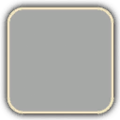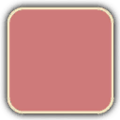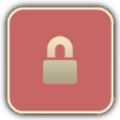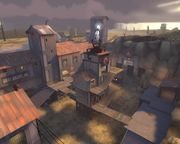List of game modes
Team Fortress 2 has seven game modes. Initially, the game shipped with just three, however, numerous updates have added new game modes, such as Payload, Arena, and King of the Hill, spread across 39 official maps.
Contents
Capture the Flag
| “ | Wave goodbye to ya secret crap, dumbass!
Click to listen
— The Scout
|
” |
Capture the Flag features both RED and BLU with their own Intelligence briefcase (known as the flag). The goal for both teams is to capture their enemy's Intelligence continuously until they have reached the game's capture limit (default limit is 3) whilst preventing their enemy from achieving the same.
Both team's Intelligence are typically located deep within their territory, usually in a symmetrical location from each other, in an area known as the 'Intelligence Room'. To take the Intelligence the player must touch their enemy's Intel. Whilst holding the enemy's Intelligence, the player must bring it to the location of their Intelligence where they must enter their 'capture zone' (indicated by the yellow and black lines) in order to make a successful capture. After each successful capture, your team will be rewarded with ten seconds of crit boost.
If the Intelligence carrier is killed or the Intelligence is intentionally dropped, the Briefcase will remain stationary for 60 seconds, with a timer shown above the Intelligence indicating how much time is left before it is returned to the Intelligence room. During that time the Intelligence can be re-captured by walking over it in the same fashion of capturing it at its starting location. Each time the Intelligence is dropped, the timer is reset. The enemy cannot move or reset the intelligence themselves. The intelligence cannot be carried by players with an invulnerability buff (i.e. Übercharged players, Scouts under the effects of Bonk! Atomic Punch) and intelligence carriers cannot receive an invulnerability buff.
If the intelligence carrier dies in a normally inaccessible part of the map (i.e. falling into a pit) the Intelligence is immediately returned to its starting location in the Intelligence room. If no team completes the capture limit before time runs out, the match will enter Sudden death mode.
Unlike variants of Capture the Flag in other games, you can make a capture without actually having your Intelligence at your base.
Capture the Flag maps:
Control Point
See also: Control points
| “ | This point ain't gonna cap itself! Get over here!
Click to listen
— The Engineer
|
” |
Control point maps carry the cp_ prefix and have two main types of gamemode (explained below). The control points are circular platforms with a team-colored light in the center projecting a hologram of the logo of the team currently occupying the point. Control points are typically located on, in or near points of interest.
To capture a point owned by the enemy team, the offensive players must simply stand on the point until the capture meter fills with their team color. The more people of the same team on a point, the faster it will capture, though only to a limited extent. Scouts have double the capture rate of any other class, although a Soldier or Demoman with the Pain Train equiped will also count as two people. No capture progress can be made when players of both teams are on the point. If all capturing players are killed or driven off before the capture is completed, the capture progress will not reset immediately but instead will slowly fade away. Control points cannot be captured or defended by invulnerability buffed players.
There are three statuses for a Control Point:
Standard Control Point
These maps are designed in a symmetrical fashion to avoid giving either team an unfair advantage, similar to the Capture The Flag maps. Both teams start with an equal number of controlled points with the central point in neuteral status. Once a point is captured, the timer resets and the next respective control point is unlocked for capture. The team to capture all the points wins. Traditional Control Point maps will go into Sudden death (or Stalemate) if no team captures all the points before times runs out. Control points close to a team's spawn point are captured more quickly by the enemy team. For example, on Well, a lone Scout can capture the final control point in a single second.
Attack/Defend
These maps are designed asymmetrically, contrary to the standard control point maps. RED begins with all the points in their control and defend against BLU, whose goal is to capture all RED's points. RED wins if it prevents BLU from capturing all points before the timer expires. Points captured by BLU are typically locked and cannot be taken back.
Attack/Defend maps can come in various styles. Some maps such as cp_dustbowl, and cp_egypt require BLU, the attacking team, to go through multiple stages before they can ultimately win the map. If the attacking team fails to win each stage, teams will switch and the defenders will then take turn to be the attackers. Other maps such as cp_gravelpit and cp_junction, allow the attacker to capture two points in no particular order (points A or B) before attacking the final point (point C). cp_steel is a unique Attack/Defend map in that capturing each minor capture point (points A, B ,C and D) will allow better accessibility to the main point (point E), such as allowing more routes into point E or extending bridges to the point so that classes other than the Scout, Soldier or Demoman can capture it.
Territorial Control
Territorial control maps carry the tc_ prefix and are arguably the most complex map type. Each round of a tc_ map plays like a small Traditional Control Point map with one point being controlled by each team. A team wins the round when they control both points. Each round is played between two adjacent territories. The starting territories, and thus the open routes, are randomized. When all points except for one team's home territory has been captured by the other team, the final round plays like an Attack/Defend map and the defending team must prevent their final point from being captured. Once a team's home territory is captured, the opposing team is awarded a point and the map resets.
Payload
| “ | Onward, great bomb-cart!
Click to listen
— The Heavy
|
” |
Payload maps carry the pl_ prefix. In Payload maps, BLU team must escort a cart full of explosives through a series of checkpoints and into RED's base within a certain amount of time. BLU team members move or 'push' the cart by standing next to it - the more people nearby the cart, the faster it moves. There is a limit of 3 BLU players (x3) for purposes of making the cart move faster, and adding more players (x4 or more) does not make the cart speed up further. (Video Link) Additionally, even a single RED team member standing near the cart will stop it from venturing further at all. If no BLU player pushes the cart after 30 seconds have passed, the cart will start moving backwards slowly until it reaches a checkpoint/BLU spawn or a BLU player stands next to it again. The cart works as a level 1 dispenser for BLU team (and disguised enemy spies) to restore health and ammunition to those pushing it.
These maps traditionally have one-way routes from the BLU side, sometimes closed off until a specific point is taken. A good example are the two alternate routes that unlock once the first checkpoint is taken on stage 1.
Both Gold Rush and Hoodoo are split into three stages - A, B and C - that BLU must advance through to win. Rounds A and B have 2 checkpoints, while stage C has 3 checkpoints in Gold Rush and 2 in Hoodoo, counting the final point. Advancing the cart to the next checkpoint gives the BLU team additional time. Advancing it to the final point moves the map to the next stage. When the cart reaches the final point on the final stage, the payload explodes and destroys the RED base, symbolizing BLU's victory.
Badwater Basin and Upward are Payload maps that only consist of a single round with 4 checkpoints. They tend to be longer, more momentum-based maps.
The Payload game mode was added in the Gold Rush Update (taking its name from the map), being the first new game mode introduced after the game's release.
Payload Race
Payload Race maps carry the plr_ prefix. Unlike standard Payload maps, Payload race maps feature both RED and BLU issued with a cart, thus teams are not defined to an attacking or defending role. To win, each team must simultaneously push their cart through enemy territory to reach the finishing point while preventing the enemy team from doing the same. As with Payload mode, team members push the cart by standing next to it, with more members increasing the speed of the cart and any opposing team members standing near the cart will stop it.
Unlike payload mode, the cart will not move backwards after any duration and there is no time limit; the map will only end when one team succesfully pushes their cart to the finish point. Each cart works as a dispenser for their team (and disguised enemy spies), restoring health and ammunition to those pushing the cart. Parts of the track may feature slopes, on which the cart will quickly roll back down to the bottom unless it is being constantly pushed.
Arena
| “ | I say this to you with the unvarnished factualism of plain talk: I love Arena Mode.
— Abraham Lincoln, Second Inaugural Address, 1865
|
” |
Arena maps carry the arena_ prefix, and the first five (Lumberyard, Ravine, Badlands, Granary, and Well) were introduced as part of the Heavy Update. This game mode was designed to keep the class diversity of Team Fortress 2 while focusing goals around combat between two teams. Whereas other modes lean towards a broad, overall strategy for the team, Arena concentrates on the specific tactical choices the teams make in a single fight.
Arena features smaller maps that play out for shorter periods of time. The round ends once one team has no players left in the arena, or when the central capture point has been captured. The central capture point unlocks after one minute has passed in the current round. Rounds tend to be very fast and highly competitive, with an emphasis on your team's class makeup and your plan to counter the opposing team's class choices. Arena mode is great for smaller matches of three vs. three players, while still comfortably supporting huge knockdown twelve-on-twelve brawls. Arena works much like Sudden Death - respawning is disabled and there are no resupply lockers. There are usually very few health kits available, often located far away from the action and/or near high-risk hazards. This forces teams to rely more on dispensers and Medics.
Players may have to sit out to keep team numbers equal if they were on the losing team, but players on the winning team never have to sit out the next round.
The First blood crit buff is unique to the Arena game mode, and was added in the Scout Update.
King of the Hill
| “ | Since their discovery in 1895, hills have fascinated kings.
— The Classless Update
|
” |
King of the Hill maps carry the koth_ prefix and use a similar layout to Arena maps. King of the Hill focuses on a single control point at the center of the map, which is locked and neutral at the beginning of the round. Teams must make their way to the Control Point and capture it when it becomes available. Once the point is captured by a team, their team clock will start a three minute countdown. If the enemy team manages to capture the point back, their clock will start counting down while the other team’s clock freezes at the time the point was recaptured.
This mode was introduced as part of the Classless Update, with Viaduct and two repurposed Arena maps, Nucleus and Sawmill.
Training Mode
Training maps are made specifically for teaching people the basics of gameplay and advanced techniques. Training mode shipped with the Mac Update, which introduced two official training maps.
Other modes
Highlander
| “ | There can be only one!
Click to listen
— The Demoman
|
” |
Applicable to all existing game modes, Highlander mode restricts the number of players of each team to 9 players, and only allows one player per class on each team. It is applicable to any game mode, and can be activated by entering mp_highlander 1 into the console.
The idea behind Highlander mode existed previous to its official inclusion in the game, and has been implemented in server mods. Highlander mode was officially added in the February 3, 2010 Patch.
See Also
External Links
| Languages: | English · العربية · čeština · dansk · Deutsch · español · suomi · français · magyar · italiano · 日本語 · 한국어 · Nederlands · norsk · polski · português · português do Brasil · română · русский · svenska · Türkçe · 中文(简体) · 中文(繁體) |













